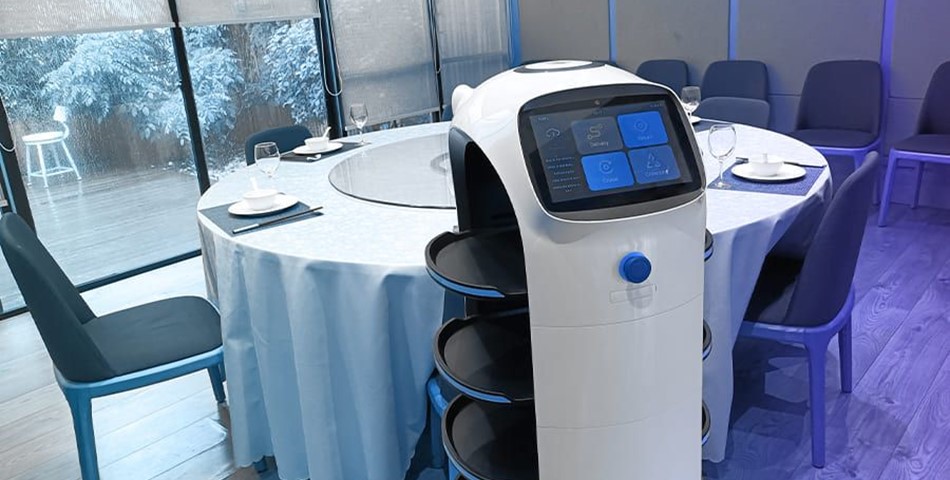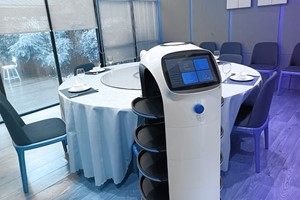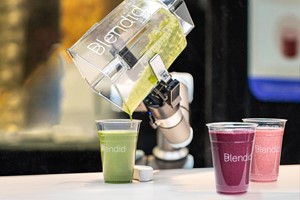Robots in restaurants and bars are making the hospitality industry safer, more efficient and reliable.
Last year has been a rough road for everyone, especially for the hospitality industry. Initially, restrictions came for dine-in, lockdown happened, then because of the social distancing rules the number of people indoors were restricted. Bars and Restaurants had to cut off their staff, even shut down due to losses in their business.
Now as the situation is getting better, the hospitality industry is expecting to overcome their loss and get back to their business but are having difficulty hiring enough staff. So as of now, some bars and restaurants are relying on automation as a solution to the shortage of staff.
According to a report by Allied Market Research - The hospitality robots market size was valued at $295.5 million in 2020, and is estimated to reach $3,083 by 2030, registering a CAGR ( Compound Annual Growth Rate ) of 25.5% from 2021 to 2030. The pandemic accelerated the adoption of robots and hence many restaurants have been renting robots as waiters. Robots can’t get sick or spread diseases, so they are safe and reliable.
Espartaco Borga, owner of La Duni in Dallas, told CNN the robot’s welcome guests and take food to tables. They can also laugh and sing "Happy Birthday”, using the robots was a "no-brainer" to fill the gaps in his workforce, he said.
A California Arby's drive-thru installed a voice-assistant robot to take orders, and the owner redistributed workers to the kitchen due to a lack of staff, AP news reported.
Carlos Gazitua, CEO of Sergio's Restaurants, told NBC Miami - "We’ve been struggling to find labor, everyone is in the entire market, not just restaurants. And we had to see what we could do fishing from the same pond. Robots became a solution.” Gazitua found his robot worker at Bear Robotics, a startup that offers “Servi,” a robot that’s taken three years to develop. With the push of a button, Servi can autonomously deliver food and drinks to tables and kitchens.
Advancement in technologies has given a ray of hope and created multiple opportunities for the hospitality industry to enhance their guests’ overall experience and make their work easier. Many would think that robots simply might replace humans but that’s not the case, as to operate them, give them instructions on what to do next, humans will be needed to work hand-in-hand to help the machine and not vice versa.
Hospitality robots’ market
The hospitality robots market size was valued at $295.5 million in 2020, and is estimated to reach $3,083 by 2030, registering a CAGR of 25.5% from 2021 to 2030.
A robot is any device or system designed to perform a specific set of tasks such as unparalleled efficiency and accuracy. For example, from the hotel's perspective, the main goal of robots is to improve and speed up the overall guest experience. This can be done in many ways such as greeting and welcoming guest, guiding them to their rooms and accurate floor, and offering snacks to customer at late night orders. Robots can automate many services without affecting availability. The entire hospitality industry is quickly adopting robotic automation in their hospitality services. Hotel robots will become popular in the near future.
Robots have been launched in various industries, but have never received its due value. Japan-based Henn-na Hotel is the first hotel in the world where the entire staff is robotized. Throughout the hotel, robots are deployed to provide various services such as providing information, front desk services, and storage services as well as check in and check out services with technology, including voice and facial recognition.
However, the pandemic created buzz in the hospitality robots market. Attributed to COVID-19, cleaning and disinfecting public areas, such as hotels, hospitals, railways stations, and airports, has been the top priority, which created more demand for disinfection robots. Many countries have opened their borders and welcomed people. The tourism industry has accelerated again, and many hotels have provided isolation time for guests. Attributed to the pandemic situation, most hotels reduced employees for lesser interpersonal communication and minimized the spread of the virus. However, the hotel’s work and care of its guests must reach the most satisfactory level. To fill the gap in human services in the hotel industry, robots are now needed to serve guests on time and meet their expectations. During this time, every hotel has faced challenges to satisfy its loyal customers. In such situation, robots play a crucial role by providing touch free, hygienic, and 24/7 services to their guests. Thus, the COVID-19 pandemic accelerated the growth of the hospitality robots market during the pandemic and is expected to sustain hospitality robots market growth after the pandemic.
Decreasing the number of staff members in hotel, quick adoption of robotic automation in hospitality industry, and guest demand for contact free and touch-free services are expected to drive hospitality robots market growth during the forecast period. Furthermore, advancement in functionalities of hospitality robots, such as face and voice recognition, to improve the next conversation with the same guest, remote control and Wi-Fi inability, and growing inclination of the hotel services providers for providing 24/7 services to their guests. Security check is one of the major concerns for the guest. Thus, in most cases, the hotel’s security robots are deployed, which are programmed to check the unexpected and objectionable objects found in hotel areas, which further accelerate the demand for hospitality robots in travel, tourism, and hospitality industry












